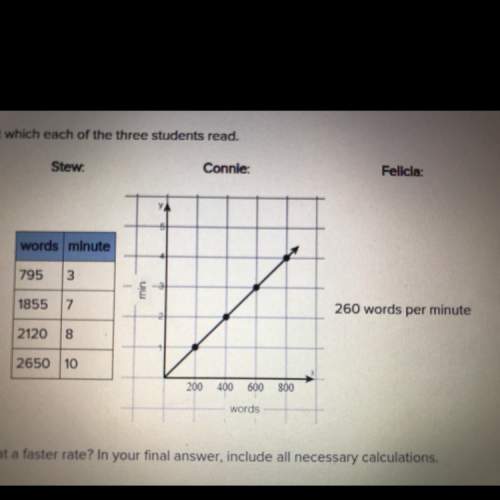Part 2
Organize your data and find the rate of change.
Create a table of the measuremen...

Mathematics, 16.12.2020 17:30 RealStephani
Part 2
Organize your data and find the rate of change.
Create a table of the measurements for your data. Label the forearm measurements as your input and the foot measurements as your output.
Select two sets of points and find the rate of change for your data.
Describe your results. If you had to express this relation as a verbal statement, how would you describe it?
Part 3
Compare rates of change.
The equation below can be used to find the length of a foot or forearm when you know one or the other.
(length of the foot) = 0.860 • (length of the forearm) + 3.302
If you let y = length of the foot and x = length of the forearm, this equation can be simplified to
y = 0.860x + 3.302.
Using this equation, how long would the foot of a person be if his forearm was 17 inches long?
What is the rate of change of the equation from Part A?
Compare the equation from Part A to your data. Are they the same? Which has a greater rate of change? Why do you think the values are different?
Is the relation in your data a function? Why or why not? Could the equation in Part A represent a function? Why or why not? Explain your answer.
For this option you will submit the details from all three parts. Submit your measurements, the table, and description that you created in Parts 1 and 2. Submit your answers to the questions from Part 3.
Forearm(input x) 8 9 10 11 11
Foot(Output y) 6 8 9 8.5 9.5

Answers: 3


Another question on Mathematics


Mathematics, 21.06.2019 18:30
What is the value of x in the following equation? -3x-2=2x+8
Answers: 1

Mathematics, 21.06.2019 20:30
Daryl factors the polynomial p(x)=x3+x2−26x+24 to rewrite it as p(x)=(x+6)(x−4)(x−1). which equations must be true? there may be more than one correct answer. select all correct answers. p(1)=0 p(−4)=0 p(−1)=0 p(6)=0 p(4)=0 p(−6)=0
Answers: 1

Mathematics, 21.06.2019 22:10
This is a rational expression because the denominator contains a variable. this is a polynomial with 3 terms. this is a rational expression because the denominator contains a variable. this is a polynomial with 4 terms. this is a rational expression because the denominator contains a variable. this is a polynomial with 4 terms. this is a rational expression because the denominator contains a variable. this is a polynomial with 3 terms. this is a rational expression because the denominator contains a variable. this is a polynomial with 5 terms.
Answers: 2
You know the right answer?
Questions


Biology, 03.12.2020 01:50

Mathematics, 03.12.2020 01:50



Social Studies, 03.12.2020 01:50

Mathematics, 03.12.2020 01:50

Mathematics, 03.12.2020 01:50




History, 03.12.2020 01:50

Health, 03.12.2020 01:50

History, 03.12.2020 01:50



History, 03.12.2020 01:50

Mathematics, 03.12.2020 01:50


Mathematics, 03.12.2020 01:50




